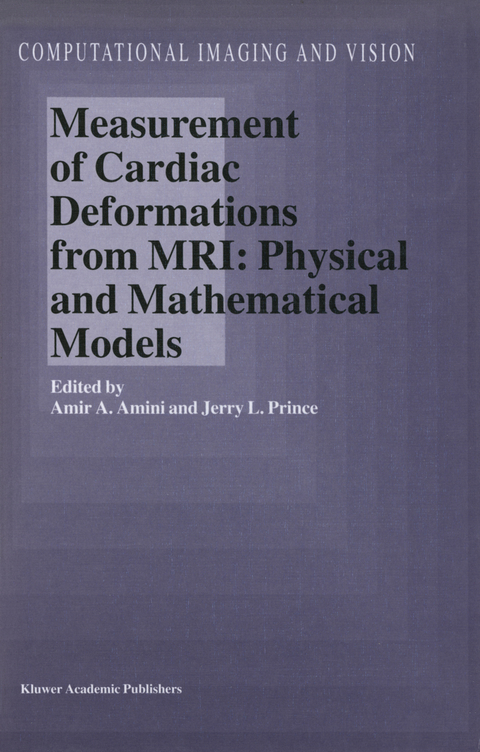
Measurement of Cardiac Deformations from MRI: Physical and Mathematical Models
Springer (Verlag)
978-90-481-5919-2 (ISBN)
Biomedical engineers, medical physicists, computer scientists, and physicians interested in learning about the latest advances in cardiovascular MRI should find this book to be a valuable educational resource. In particular, it is more tutorial in nature than most of the technical papers where the research was originally published. Practitioners and researchers working in the field of cardiovascular MRI will find the book to be filled with practical technical details and references to other work, enabling the implementation of existing methods and serving as a basis for further research in the area.
1 Regional Stress and Strain in Healthy and Diseased Ventricular Myocardium.- 1.1 Introduction.- 1.2 Ventricular Geometry and Structure.- 1.3 Regional Myocardial Mechanics.- 1.4 Engineering Models of Wall Stress.- 1.5 Analyzing Wall Strain Distributions.- 1.6 Regional Strain Distributions in Disease.- 1.7 Future Directions.- Acknowledgments.- References for Chapter 1.- 2 Clinical Applications of Cardiac Tagging.- 2.1 Introduction.- 2.2 Imaging Techniques.- 2.3 Tagged Image Data Analysis.- 2.4 MR Tagging in Normal Human Heart.- 2.5 MR Tagging in Ischemic Heart Disease.- 2.6 MR Tagging in Left Ventricular Hypertrophy.- 2.7 Cardiomyopathies.- 2.8 Right Ventricular Mechanics.- 2.9 Pericardial Constriction.- 2.10 Summary.- Acknowledgments.- References for Chapter 2.- 3 Finite Element Modeling for Three-Dimensional Motion Reconstruction and Analysis.- 3.1 Introduction.- 3.2 The Finite Element Model.- 3.3 Model Tags: 3D Formulation.- 3.4 Reconstruction of RV Surface Deformation.- 3.5 Principal Component Analysis.- 3.6 PCA of Normal Geometry and Deformation.- 3.7 Future Work.- References for Chapter 3.- 4 Modeling and analysis of the RV and LV from MRI-SPAMM.- 4.1 Introduction.- 4.2 Biventricular Model Geometry.- 4.4 Motion and Deformation Analysis.- 4.5 Results.- 4.6 Discussion.- 4.7 Conclusions and Future Work.- Acknowledgments.- Finite Element Shape Functions.- Strain Calculation Using Finite Elements.- References for Chapter 4.- 5 Motion Analysis of the Whole Heart.- 5.1 Motivation and Background.- 5.2 Introduction and Background.- 5.3 Methods.- 5.4 Results.- 5.5 Discussion.- 5.6 Conclusion.- Acknowledgments.- References for Chapter 5.- 6 Harmonic Phase MR.- 6.1 Introduction.- 6.2 A Harmonic Model of Tagged MR Images.- 6.3 HARP Motion Measurement Principles.- 6.4 CINE-HARP(CHARP) Methods.- 6.5 Single-shot HARP (SHARP) Methods.- 6.6 Combining CHARP and SHARP Methods.- 6.7 Summary and Conclusion.- Acknowledgments.- References for Chapter 6.- 7 Automated Tag Detection.- 7.1 Introduction.- 7.2 Signal Models.- 7.3 Tag Center Estimation.- 7.4 Hypothesis Testing.- 7.5 Algorithm Implementation.- 7.6 In Vivo Experiments.- 7.7 Discussion.- Acknowledgments.- Likelihood Function Derivative.- References for Chapter 7.- 8 Analysis of Tagged MR Cardiac Images with B-spline Models.- 8.1 Introduction.- 8.2 B-spline basics.- 8.3 Coupled B-snake Grids.- 8.4 Constrained Thin-Plate Spline Reconstruction.- 8.5 Measurement of 3D Motion of Myocardial Beads.- 8.6 Conclusions.- 8.7 Acknowledgments.- References for Chapter 8.- 9 MR Physics and Imaging of Phase Contrast MR.- 9.1 Introduction.- 9.2 Basic Principles of Phase Contrast MRI.- 9.3 Implementation issues.- 9.4 Data Processing.- 9.5 Results.- 9.6 Discussion.- Signal Phase.- References for Chapter 9.- 10 Myocardial Spatiotemporal Tracking.- 10.1 Introduction.- 10.2 DMESH Motion/Strain Mapping.- 10.3 Experiments.- 10.4 Discussion.- Acknowledgments.- References for Chapter 10.- 11 Computational Platforms for Integrated Cardiac Image Analysis.- 11.1 Introduction.- 11.2 Obtaining Estimates of Cardiac Displacements.- 11.3 Modeling used for Interpolation and Smoothing.- 11.5 Future Research Directions.- Acknowledgments.- References for Chapter 11.
| Erscheint lt. Verlag | 8.12.2010 |
|---|---|
| Reihe/Serie | Computational Imaging and Vision ; 23 |
| Zusatzinfo | XVI, 320 p. |
| Verlagsort | Dordrecht |
| Sprache | englisch |
| Maße | 155 x 235 mm |
| Themenwelt | Informatik ► Grafik / Design ► Film- / Video-Bearbeitung |
| Informatik ► Theorie / Studium ► Künstliche Intelligenz / Robotik | |
| Medizinische Fachgebiete ► Innere Medizin ► Kardiologie / Angiologie | |
| Medizinische Fachgebiete ► Radiologie / Bildgebende Verfahren ► Radiologie | |
| Medizin / Pharmazie ► Physiotherapie / Ergotherapie ► Orthopädie | |
| Technik ► Medizintechnik | |
| ISBN-10 | 90-481-5919-9 / 9048159199 |
| ISBN-13 | 978-90-481-5919-2 / 9789048159192 |
| Zustand | Neuware |
| Haben Sie eine Frage zum Produkt? |
aus dem Bereich


